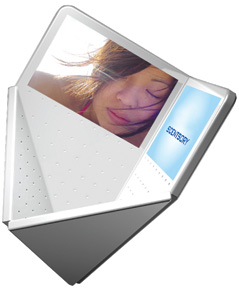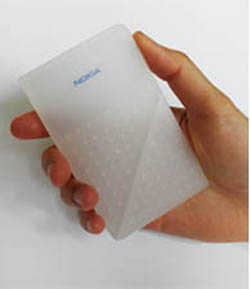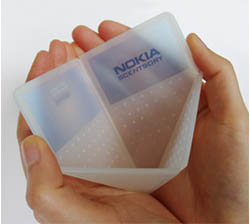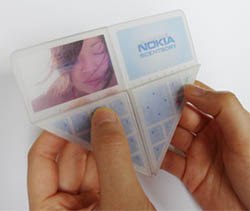One of the very last handset announcements of 2010, the Samsung Nexus S by Google is a high-end Android 2.3 smartphone that should be available by Christmas in the US and the UK.
The Nexus S is a joint effort between Samsung and Google, and it follows on from the original (and not hugely successful) Google Nexus One. The hardware on the Nexus S is very similar to the Samsung I9000 Galaxy S, so probably the biggest difference between the Galaxy and Nexus S is the software.
Android 2.3 (also known as "Gingerbread") features several improvements over previous versions, and perhaps the most important improvement is more aggressive power management by the operating system. Other improvements include faster graphics rendering, more sound features, a better camera interface, more codecs for video playback and a number of other improvements. And because this handset is developed in partnership with Google, then you can expect to see the latest software updates being available for the Nexus S before any phones.
The hardware specifications of the Nexus S are impressive. There's a large 4.0" 480 x 800 pixel AMOLED display, a 5 megapixel camera on the rear and a front-facing VGA resolution camera for video calling and application use, 16GB of internal Flash memory (but there is no memory slot), 3.5G support, WiFi (including 802.11n) and GPS plus a digital compass. Inside is a 1GHz Hummingbird CPU which should provide plenty of processing power.
Some novel features on the Samsung Nexus S include a gyroscope sensor for gaming and built-in NFC support, but perhaps most noticeable will be the slightly curved display which is designed to make the handset easier to hold up to your face.
Video recording is 720 x 480 pixels at 30 frames per second, not HD quality but good enough for YouTube, the stills camera has autofocus and an LED flash, although this isn't really a high-end camera phone. Multimedia playback on the Nexus S is much more impressive with the relatively large display and improved playback support, and Samsung's AMOLED displays are very well regarded when it comes to clarity.
Inside the Nexus S is a large 1500 mAh battery, and it's a fairly big device at 124 x 63 x 11mm and 129 grams, although that is mostly down to the large display. Talktime is quoted as being up to 6.7 hours on 3G with 18 days standby time.. but as Android users know, those applications can sometimes be very power hungry.
If you live in the UK or US, then the Samsung Nexus S will be available just in time for Christmas, on December 20th at £550 SIM-free from the Carphone Warehouse in the UK, and it will also be available from Best Buy stores in the US from December 16th (although the price is not known at the moment). Contract options are available, and other markets will follow early next year.
This phone will probably appeal to people who already have an Android handset and are looking to upgrade.. non-Android users might not understand the fuss about having the latest operating system, and there's no doubt that this is a somewhat expensive device. However, it is certainly an impressive piece of kit and it does look like Google might have their strategy right the second time around.
Labels: Mobile
CUin5 phone, the entire surface of which is composed of buttons. It has neither display nor the rear and front panels, only keys, which allows to call holding it in any position.

Labels: Mobile, Stylish Mobile
The entire front panel of the phone is made as a touch display, which was so amusing a year ago.

Labels: Mobile, Stylish Mobile
Phone № 1, another phone, which shows how fantasy became a reality. A form of the shell and rounded corners, and this concept does recalls iPhone.

Labels: Mobile, Stylish Mobile
This concept from BenQ-Siemens designers can be winded on a hand as a bracelet. It can twist like a snake.

Labels: Mobile, Stylish Mobile
His touch interface was designed to show what can a phone do through only one touch, as well as to illustrate how different applications can work simultaneously.

Concepts
Synaptics solutions are out in the world, providing exceptional human interfaces to a wide range of market-leading PCs, peripherals, mobile phones, and handheld devices. But we’re also thinking ahead—way ahead—and exploring the technologies that will continue to revolutionize the human interface.At Synaptics, we take great pride in the fact that our technology and innovative solutions have become part of the everyday user experience—and part of daily life. And we look forward to continually advancing the human interface with new capabilities, intuitive features, and much more.
Here you can see just a few of the human interface concepts that Synaptics researchers and thought leaders envision for the future.
Boomerang Remote – Control for the Digital Home
Designed as a command control center for all home digital entertainment, Boomerang demonstrates the functionality and industrial design possibilities of Synaptics’ core capacitive sensing technology. The concepts integrated into Boomerang are available to OEM’s interested in converging home and entertainment controls with an intuitive easy-to-use remote that features the benefits of incorporating capacitive buttons, scrolling, cursor navigation and advanced gestures, while also enabling unique and appealing industrial design without the clutter of mechanical buttons and keys. Read more.Onyx Concept – ClearPad for Mobile
Synaptics, in partnership with industrial design studio Pilotfish, collaborated in the design of the next-generation phone concept, Onyx. Enabled through Synaptics clear, capacitive sensing technology, Onyx illustrates the future of mobile communications by combining an intelligent and adaptive user interface with sleek industrial design and next-generation user interaction design. The Onyx concept acts as a remote for your life. And because life is activity based, not application based, the concept illustrates how applications such as phone, GPS, music, teleconference and calendar events can work simultaneously. The Onyx concept does not base its experience on treating applications as separate windows or entities that work in isolation. Rather, the Onyx concept seamlessly integrates functions into activity based experiences. Read more.Fuse™ Concept – Mobile Interaction Beyond the Touchscreen
Synaptics collaborates with leading handset ecosystem partners Texas Instruments, Immersion, TheAlloy, and The Astonishing Tribe to drive the future of mobile interaction beyond the touchscreen. Fuse integrates multiple interface technologies—including multi-touch capacitive sensing, haptic feedback, 3-D graphics, and force, grip, and proximity sensing—the Fuse concept phone showcases exciting new mobile device usage models that Improve usability for single-handed usage and no-look operation on touchscreen handsets. In addition, Fuse demonstrates to device manufacturers the value of ecosystem collaborations providing a model for designing multi-modal interfaces that will optimize the user experience on next-generation handheld device. Read and view more.Labels: Mobile, Stylish Mobile
This concept phone has a transparent shell and an LCD display, but its size and thickness don’t exceed a credit card, so that it can be put together in your wallet with other credit cards.

Labels: Mobile, Stylish Mobile
A telephone of the future from NEC, really looks like Nokia 888: the same form, the same possibility of transformation and acquisition of corps. However, the phone remains only a fantasy of designers.

NEC tag looks very similar to nokia 888.It can remember shape and can be changed according to users mode.The pressure sensing elements present everywhere in the phone make it possible to remember shape.It can be wrapped around arm or waist.


Labels: Mobile, Stylish Mobile


Smell, the most evocative of the senses, can unconsciously trigger entire memories, complete with deep-rooted associated emotions. The average human is able to recognise approximately 10,000 different odours. Over time, odour-memory remains as other recollections fade. People recall smells with 65% accuracy after a year, while visual recollection of photographs sinks to about 50% after only three months.Nanotechnology plays a key role in the development of this new device. Using highly sophisticated sensors, the electronic ?nose? samples the odour of the caller?s environs and transmits this to the recipient electronically. Scientists have found that a distinct genetic pattern is associated with every odour, so it is simply a matter of matching electrical harmonics with gene activity. This way, the perception of a smell by electrical stimulation could be technologically induced.



Labels: Mobile, Stylish Mobile

While not widely acknowledged, introduction of Apple iPhone seems to have sent a shockwave throughout cellphone industry and left major vendors scrambling to produce their own answer to it.
Only LG seems to have had something at least a little bit similar to iPhone with their LG Prada KE850 phone. Other vendors were left churning out the concept phones on YouTube.
And here’s another concept phone – Asus Aura, produced by Hungarian design company Egy Studio for Taiwanese vendor. It was clearly inspired by iPhone, although it has some interesting innovations addressing commonly mentioned shortcomings of Apple’s cellphone.
One of them is a movable navigation module with navigation buttons, another – a sliding QWERTY keyboard that should make text entry much easier.
Other features of Asus Aura include – 3,9″ touchscreen covering the whole surface of the phone, 2 megapixel camera, microSD memory card slot, GSM, UMTS, HSDPA, Wi-Fi and Bluetooth connectivity. All of this in a 6mm thick package.
Unfortunately Asus Aura is just a concept so far and will stay that way probably a few years.
With the dimensions of 97x49x6mm and total volume of 28 cc, Asus aura is several times smaller then what current HSDPA chipsets allow to be. But with Moore’s law and competition among communication chip makers in full swing, who knows? We might see it sooner.

It seems that everyone is coming out with their own version of a touchscreen, keyless phone these days. ASUS apparently is no exception with their own announcement of the ASUS Aura, however their phone also has a QWERTY keypad that folds out and a 2-megapixel camera.
Like the iPhone, the ASUS Aura can work in both horizontal and vertical modes, switching automatically when you flip the phone around. It features a nice 3.9-inch touchscreen display, as well as Bluetooth, a microSD card slot and miniUSB connectivity. The Aura is pretty darn thin at just 9mm, which makes this the perfect size to carry easily in a pocket or purse. It is a great multimedia device, allowing you to take photos, watch movies, etc. It works on GSM networks, and features internet connectivity through 3G (including HSDPA) and WiFi.
The one thing this phone that others do not is the QWERTY keyboard. You can use either the touchscreen or the keypad, depending on your preferences. I think this is a great option, and will help sales of the device. It looks really cool!
GSM, 3G, including HSDPA, and also the wireless networks Wi- fie and interface Bluetooth 2.0. And all this with the thickness of 6 mm. overall sizes are assumed such: 9"khya9kh' mm. that zh, will be healthy, if they sometimes personify development into the life.
Labels: Mobile, Stylish Mobile

We love fun, implausible concept designs as much as the next guy, but this one in particular seems kind of far-fetched. The "Nokia Open" is/would be a cell phone that opens like a fan with a "scrollable touch screen," which seems to be an essential-yet-nonexistent item that would need to be invented in order for this to work. The idea is that with the push of a button the thin phone opens up, revealing a spacious screen on which buttons and menu options appear for you to manipulate with your digits. All well and good, but a cell phone that appears before you on the wings of a magical eagle would be cool too, though I'm not expecting Nokia to start marketing it anytime soon. Perhaps with the advent of flexible e-paper on the horizon, this isn't totally unimaginable, but it certainly is at least a decade off. Eventually we'll probably see flexible displays used in portable devices in some regard, but to design devices before the technology is… well, science fiction, really. But hey, designer Hugo Danti should keep up the Photoshopery; he's got talent.
Labels: Mobile, Nokia Mobile, Stylish Mobile

*design concept
“Form follows you”
A personal mobile communication device which lets you be free and fun. It is light, simple and carefree. You can change its form according to your needs during the day.
*target
It is targeted to the young consumers who are likely to be active and take place in a lot of different activities.
*why this target ?
Because they move and change place too much. They do a lot of different things during the day. So that’s what my design offers : to adjust to the moment, the place and the function.
*technologies that are used
It uses liquid battery, speech recognition, flexible touch screen, touch sensitive body cover which lets it understand and adjust to the environment. It has a simple programmable body mechanism so that it changes forms in different situations.
*the functionality of design
You dont have to carry it in your pocket or on your wrist. You can carry it anywhere, in anyform. You can roll it, bend it, put on your clothes like a clip. It also makes some form changes that makes it more ergonomical: i.e. when you want to talk on the phone, the body form turns into the form of the good old telephone. You can personalize these forms and record them. So it fits you the best in the way that you have chosen. The functions that it has also create a feeling of electronical pet, as it senses your moves, understand what you want, respond you in the best way. It learns you, to fit you better.Also e-motions lets you send forms to the other 888 users. It could be the shape of a heart or a small dance. This way you can talk without words.
*how the user interacts
E-motions… It means electronical motions that 888 has. You can send and receive forms from / to friends. You can send a heart shape to your girlfriend, so her telephone turns into an icon of heart. Or you can send a dancing form to your friends to call them to the party tonight. This is the fun side of the product. If we look from the functionality side, 888 is quite flexible. You can put it into your pocket, roll it and make it smaller, or put on your wrist when you want to make a video call on the go. If you want to talk like a normal telephone, there you have your telephone shape. We go through a lot of places and situations in the daily life, so it seems like one form is not enough.
*what is unique ?
You can change the form of the body. Not just the color. And you can do the same by sending an e-motion to your friend.
*the inspiration
The idea is that “the perfect form” does not exist. “Form follows you”
We create the perfect form for each function.
Tamer NAKISCI
industrial designer
Mimar Sinan University of Fine Arts
Istanbul / TURKEY


Labels: Mobile, Stylish Mobile

Virtual reality goggles are goggles which are designed to be used in a virtual reality experience, in which scenes are displayed in the goggles, allowing the user to feel like he or she is actually inside the scene, experiencing it first hand. Many virtual reality goggles are not actually goggles at all, but rather head mounted displays which wrap around the face. The goggles are also usually worn with a headset for the purpose of isolating sounds from the surrounding environment and providing a source of audio input.
There are a number of different applications for virtual reality goggles. Many people think of such devices in the context of virtual reality games, in which players don goggles and headsets so that they can feel like they are experiencing the game first hand. Such games can be played solo or with groups, providing opportunities to react with a virtual environment which can be enhanced with the use of specialized gloves and other equipment. In addition to being used in games, such goggles can be used more educationally, with people taking virtual tours of museums or sites of interest around the world.
Virtual reality goggles are also used in certain teaching applications, providing people with simulated experiences they can respond to. Using virtual reality goggles can allow people to explore situations and environments which would otherwise be highly unsafe, making them valuable for instruction like pilot training, in which it is not possible to put pilots in dangerous situations to see how they respond.
Medicine also has uses for virtual reality goggles. Tests used to assess visual acuity, for example, can be performed with a virtual reality experience which simulates real world conditions and makes it easier to collect accurate information. Goggles are also used in some biofeedback therapy, in which a game is created for a patient to navigate as he or she works through the therapy. Practitioners such as dentists may also provide their patients with virtual reality goggles so that they can escape, as it were, during dental treatments, lowering stress and making the experience more pleasant.
Labels: Mobile

We know that Nokia is always looking towards the future of mobile communications, remember the Nokia Aeon Concept PhoneMorph, and Nokia's future mobile phone design concept videos? Well, the Nokia Research Center has now teamed up with the University of Cambridge on a joint nanotechnology concept called Morph. It basically demonstrates how future mobile devices might be stretchable and flexible, allowing a user to transform their mobile device into radically different shapes, using bendable nanotechnology materials of course.
"Developing the Morph concept with Nokia has provided us with a focus that is both artistically inspirational but, more importantly, sets the technology agenda for our joint nanoscience research that will stimulate our future work together." - Professor Mark Welland, Head of the Department of Engineering's Nanoscience Group at the University of Cambridge and University Director of Nokia-Cambridge collaboration.It's believed that elements of Morph might be available to integrate into handheld devices within 7 years, starting with high-end mobile devices. Advances in nanotechnology could lower manufacturing costs after that, so we might see a device like this hit mainstream users by the time the year 2020 comes around. If you can't wait until then, you can see more about the Morph concept and nanotech at the "Design and the Elastic Mind" exhibition, on view from February 24 to May 12, 2008, at The Museum of Modern Art (MoMA) in New York.
Labels: Mobile
showing 1-20 of 91
-

 Spice QT-68 (Black)
Spice QT-68 (Black)
 4,999 4,002
4,999 4,002 -

 Micromax Q7 (Black)
Micromax Q7 (Black)
 5,555 4,037
5,555 4,037 -

 Micromax Q7 (Silver)
Micromax Q7 (Silver)
 5,555 4,037
5,555 4,037 -
 Samsung C3303K (Black)
Samsung C3303K (Black)
 4,201 4,090
4,201 4,090 -
 Intex IN 6633 (Black)
Intex IN 6633 (Black)
 4,397
4,397 -

 Micromax Q75 (Black)
Micromax Q75 (Black)
 5,208 4,489
5,208 4,489 -

 Spice QT66 (Black)
Spice QT66 (Black)
 5,999 4,620
5,999 4,620 -

 Karbonn K30-Wi-Fi (Black)
Karbonn K30-Wi-Fi (Black)
 5,290 4,634
5,290 4,634 -
 VOX-VGS-705 (Brown)
VOX-VGS-705 (Brown)
 5,849
5,849 -

 Infibeam I666 (Black)
Infibeam I666 (Black)
 7,499 5,999
7,499 5,999 -

 Samsung Corby Colours S3653IK (Black)
Samsung Corby Colours S3653IK (Black)
 8,000 6,467
8,000 6,467 -

 Samsung Star S5233W WiFi (Black)
Samsung Star S5233W WiFi (Black)
 11,500 6,566
11,500 6,566 -

 Asus P320(Black)
Asus P320(Black)
 12,900 7,099
12,900 7,099 -

 Asus P320(Brown)
Asus P320(Brown)
 12,900 7,099
12,900 7,099 -
 Nokia C3 Touch and Type (Grey)
Nokia C3 Touch and Type (Grey)
 7,200
7,200 -

 Samsung Wave525-S5253 (Black)
Samsung Wave525-S5253 (Black)
 8,800 7,475
8,800 7,475 -

 Samsung Wave533-S5330 (Black)
Samsung Wave533-S5330 (Black)
 9,900 8,849
9,900 8,849 -

 Samsung S5620 Monte (Black)
Samsung S5620 Monte (Black)
 12,390 8,908
12,390 8,908 -

 Sony Ericsson Elm J10i2 (Black)
Sony Ericsson Elm J10i2 (Black)
 15,000 8,918
15,000 8,918 -

 Nokia E63 (Black)
Nokia E63 (Black)
 16,549 9,227
16,549 9,227
Labels: Mobile